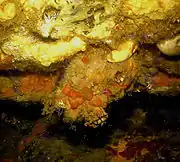Microcosmus sabatieri
Microcosmus sabatieri, commonly called the grooved sea squirt,[2] sea fig,[3] or violet,[3] is a species of tunicates (sea squirts). The species has a rocky-shape appearance. It is mainly found in the Mediterranean Sea.[4] It is used as food in parts of Europe.[2]
| Microcosmus sabatieri | |
|---|---|
 | |
| Inhalant siphon of Microcosmos sabatieri. The yellow feature at the left is a clutch of mollusk eggs. | |
| Scientific classification | |
| Kingdom: | Animalia |
| Phylum: | Chordata |
| Subphylum: | Tunicata |
| Class: | Ascidiacea |
| Order: | Stolidobranchia |
| Family: | Pyuridae |
| Genus: | Microcosmus |
| Species: | M. sabatieri |
| Binomial name | |
| Microcosmus sabatieri (Roule, 1885) | |
| Synonyms[1] | |
| |
Uses
Three species of Microcosmus are edible presently, M. sabatieri, M. vulgaris, and M. polymorphus (Vafidis 2008). In the Mediterranean Basin, it is eaten raw, often with an acidic condiment such as lemon juice or vinegar with shallots. It has a strong iodine taste which not all appreciate.
Names
The specific epithet sabatieri is in honor of zoologist Armand Sabatier.[3] The name 'violet' is from the distinguishing violet stripes on the siphon.[3]
The species has many common names. In Dutch it is violet-zakpijp (lit. violet pocket-pipe)[2] or begroeide zakpijp (overgrown pocket-pipe).[3] In French it's violet,[2][3] figue de mer (lit. sea fig),[3] and in Marseille, patate de mer (lit. sea potato),[3] or vioulé.[3] In the Catalan language it's called biju or bijut (jewel).[3] In German they use seefeige (lit. sea fig)[2] or eßbare seescheide (edible sea sheath).[3] It is Φούσκα (foúska, lit. bubble or puff) in Greek.[4] In Italian, limone di mare (sea lemon) or uova di mare (sea egg) are used.[3] Names in Spanish include provecho (profit), patatas de mar (sea potatoes), and buñuelo de mar (sea fritter).[3] In Ligurian it can be called strunsi di mare (sea turds).[3]
Other names it is sold under include:
Note that plants of the genus Carpobrotus are also known as 'sea figs'.[5]
Gallery
 Microcosmus sabatieri at Banyuls-sur-Mer
Microcosmus sabatieri at Banyuls-sur-Mer Microcosmus sabatieri at Banyuls-sur-Mer
Microcosmus sabatieri at Banyuls-sur-Mer Inhalant siphon of Microcosmos sabatieri. The yellow feature at the left is a clutch of mollusk eggs.
Inhalant siphon of Microcosmos sabatieri. The yellow feature at the left is a clutch of mollusk eggs.
References
- Shenkar, N.; Gittenberger, A.; Lambert, G.; Rius, M.; Moreira Da Rocha, R.; Swalla, B.J.; Turon, X. (2018). Ascidiacea World Database. Microcosmus sabatieri Roule, 1885. Accessed through: World Register of Marine Species at: http://www.marinespecies.org/aphia.php?p=taxdetails&id=103844 on 2018-02-13
- Beleidsinformerende Nota: Wetenschappelijke en handelsbenamingen voor visserij- en aquacultuurproducten op de Belgische markt (PDF) (in Dutch). Oostende: Vlaams Instituut voor de Zee. 12 October 2016. ISBN 978-94-92043-42-9. ISSN 2295-7464. Retrieved 13 February 2018.
Microcosmus sabatieri violet-zakpijp violet Seefeige grooved sea squirt
- Ader, Denis; André, Frédéric; Huet, Sylvie (7 August 2016). "Microcosmus sabatieri". Données d'Observations pour la Reconnaissance et l'Identification de la faune et la flore Subaquatiques (in French). Retrieved 13 February 2018.
- Sanamyan, Karen; de Jong, Y. (5 December 2007). "Microcosmus sabatieri Roule, 1885". Pan-European Species directories Infrastructure. Retrieved 13 February 2018.
Vernaculars (-) Greek: Φούσκα
- "Sea figs Genus Carpobrotus". iNaturalist. San Francisco. Retrieved 13 February 2018.
External links
| Wikimedia Commons has media related to Microcosmus sabatieri. |